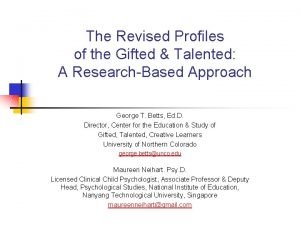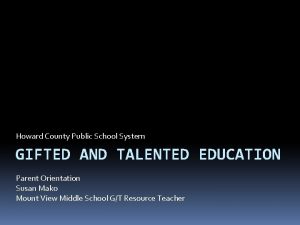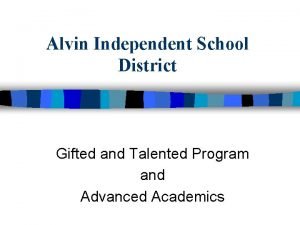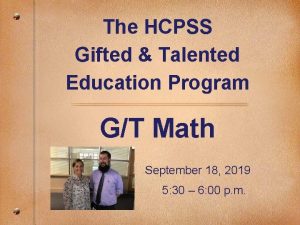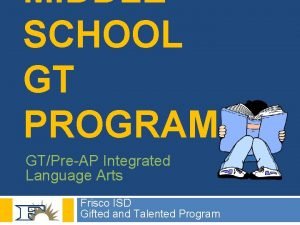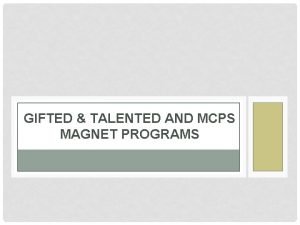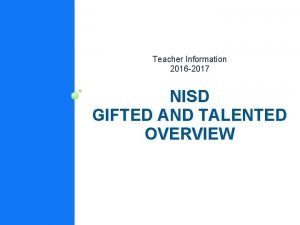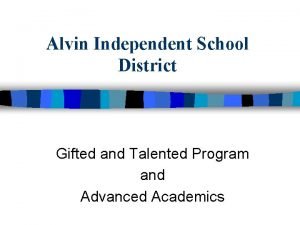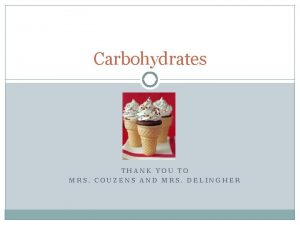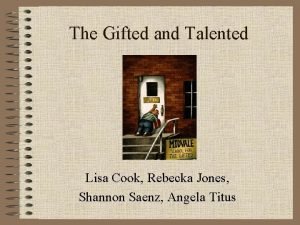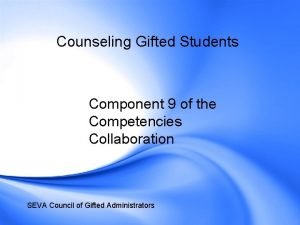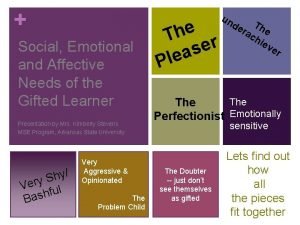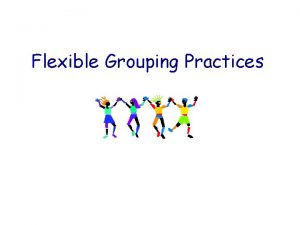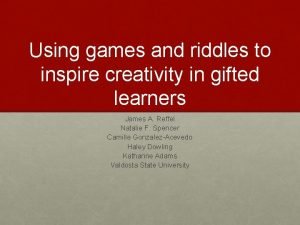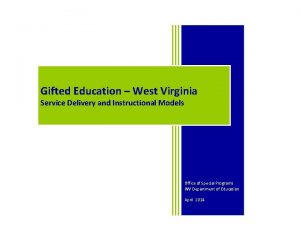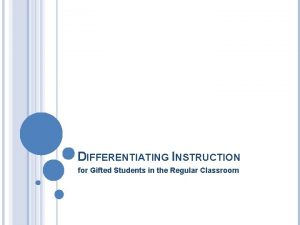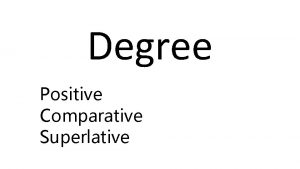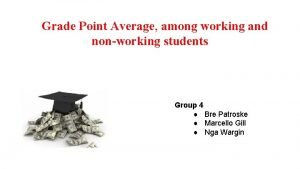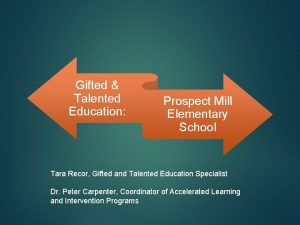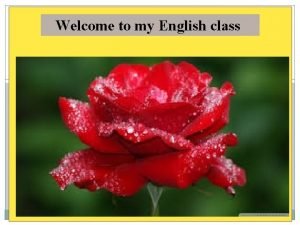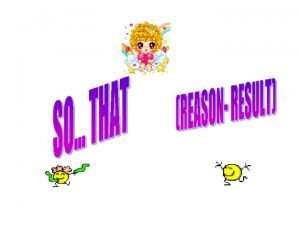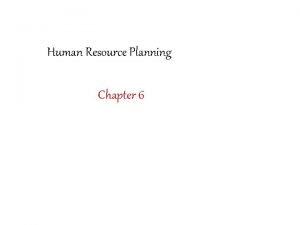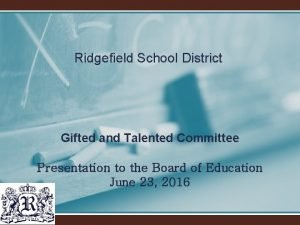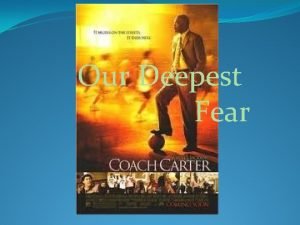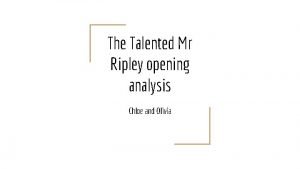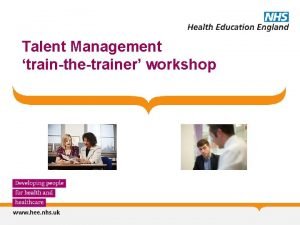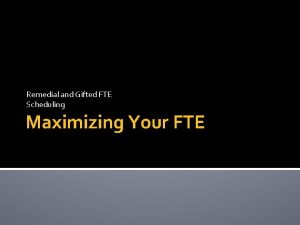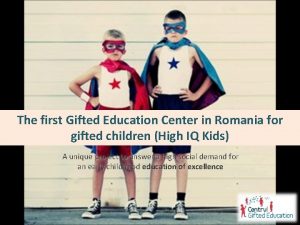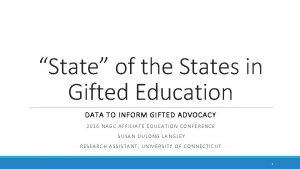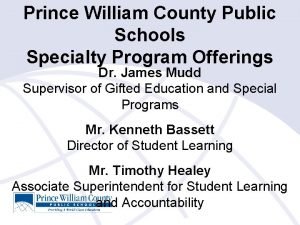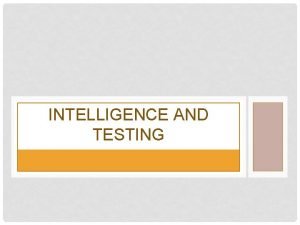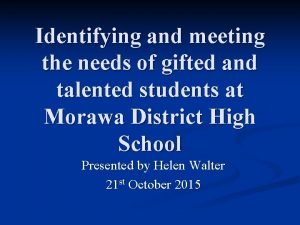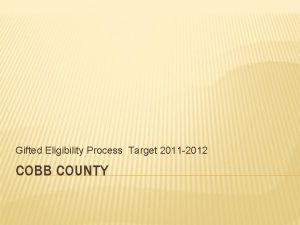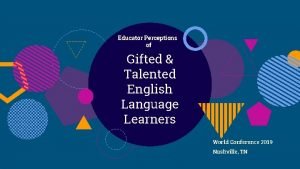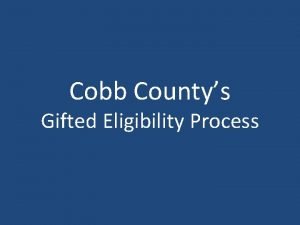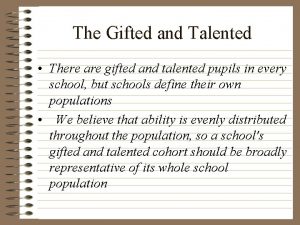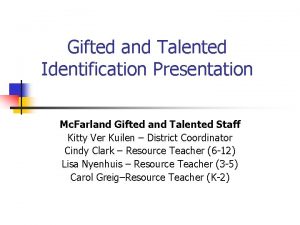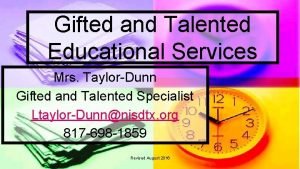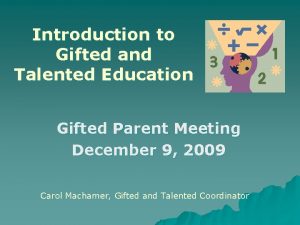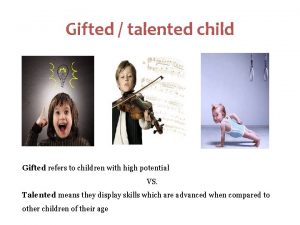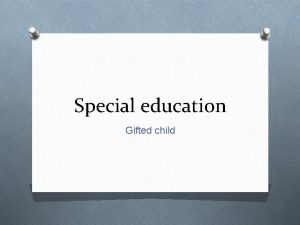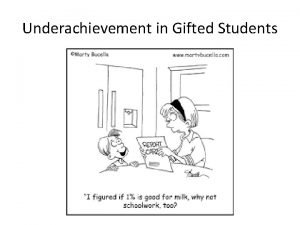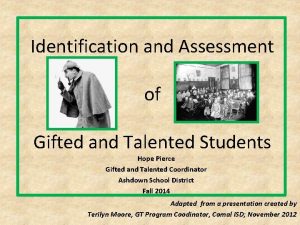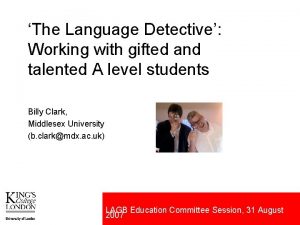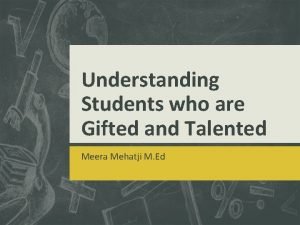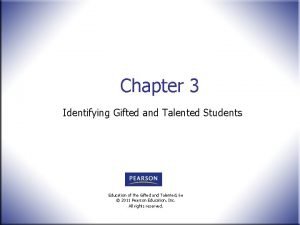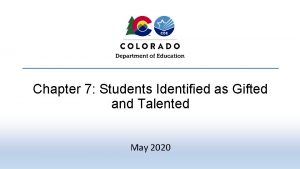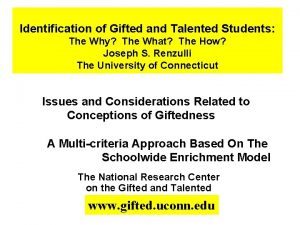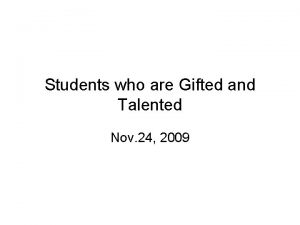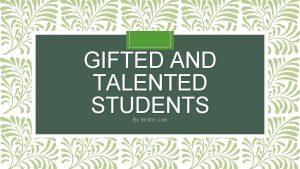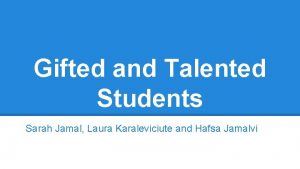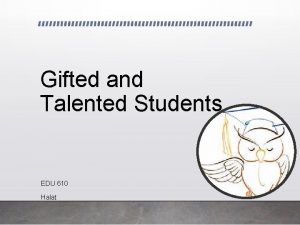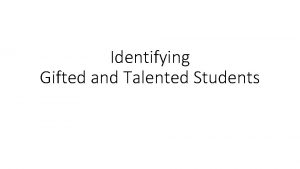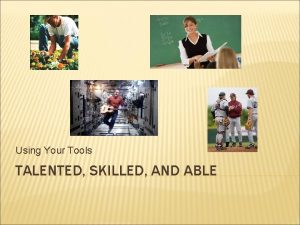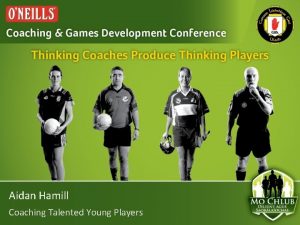Working with talented and gifted students Georgia Couzens















































![Bibliography ACARA, 2016. Student Diveristy: Gifted and Talented Students. [Online] Available at: http: //www. Bibliography ACARA, 2016. Student Diveristy: Gifted and Talented Students. [Online] Available at: http: //www.](https://slidetodoc.com/presentation_image/5e5cde47da2ca2358a8653742255f798/image-48.jpg)

- Slides: 49

Working with talented and gifted students Georgia Couzens a 1644514

Acknowledgement We acknowledge that we are meeting on the traditional country of the Kaurna people of the Adelaide Plains. We recognise and respect their cultural heritage, beliefs and relationship with the land. We acknowledge that they are of continuing importance to Kaurna people living today.

Gifted and Talented Students Gifted and talented students vary so widely that there is no one student that is the same These students require specific support to ensure that they succeed in their education For this reason, this presentation will provide you with information about the different types of gifted students It will also provide different strategies of how to better support the students in your class At the end of the presentation, there will also be a number of resources that will be listed to give your extra information about these students

Learning Outcomes By the end of this presentation, you should be able to: Identify a gifted student Understand the different types of gifted and talented students Be able to use different strategies in the classroom to help support gifted students Have a better understanding of the resources that are available to the teaching community

The First Hour Gifted and talented students information (20 mins) Break (10 mins) Review of the information (5 mins) Questions (5 mins) Activity (15 mins) Overview/Plenary (5 mins) Break

Second Hour Strategies Break for teachers to use (20 mins) (10 mins) Review of the information (5 mins) Questions Activity (5 mins) (15 mins) Overview/Plenary Break (5 mins)

Third Hour Implications for you as a teacher and resources available to you(30 mins) Break (10 mins) Review of the information (5 mins) Questions (5 mins) Conclusions (10 mins)

Gifted and Talented Students Working with a gifted student in your classroom can be either a pleasure, or it can make your classroom a very tense place To be understand why this is, you first need to understand the definition of a gifted student A gifted or talented student is often one whose intelligence is that of a high standard In Australia, Gagné’s Model of Giftedness and Talent provides the most generally accepted definition of both giftedness and talent

According to Gagné, gifted students are those whose potential is distinctly above average in one or more of the following domains of human ability: intellectual creative social Physical (Source: ACARA, 2016)

Different Profiles of Giftedness The Davidson Institute has grouped giftedness of students into 6 different categories to better understand the behaviours, feelings and needs of the gifted/talented students The groups are as follows: Type 1: The Successful Type 2: The Challenging Type 3: The Underground Type 4: The Dropouts Type 5: The Double-labelled Type 6: The Autonomous Learner

Type 1: The Successful: Children who demonstrate the behaviour, feelings, and needs classified as Type 1's have learned the system. They have listened closely to their parents and teachers. After discovering what "sells" at home and at school, they begin to display appropriate behaviour. Rarely do they exhibit behaviour problems because they are eager for approval from teachers, parents and other adults. Type 1’s often find school boring and often learn to use the system just to coast by without much effort. Those that underachieve at university level and later in adult life often come from this group as they don’t have the skills and drive to excel in this part of life. Type 2: The Challenging Type 2’s often obtain high levels of creativity and can be seen as tactless or sarcastic. These students often question authority and may challenge the teacher in front of the rest of the class. They generally don’t try to conform to the system and as a result don’t learn how to use this to their advantage. They don’t get recognised for what they do and often don’t receive rewards. Their interactions at school often involve conflict. These students resent the school system as it isn’t seen to affirm their achievements. Type 2 students run the risk of being future dropouts for drug and alcohol issues. Type 3: The Underground Type 3 gifted students are more often than not, female students. These students often supress and try to hide their gift in order to become a part of the ‘popular group’. These students generally feel anxious and out of place and this insecurity can lead to conflict with their parents and teachers. (SOURCE: Betts et al. , 1988)

Type 4: The Dropouts Type 4 students are more often than not angry at school. They’re angry at their parents, their teachers and the school. This anger stems from the lack of support that the student received earlier in their schooling career. The student’s interest is often outside of the regular curriculum and is generally not supported at a schooling level. They are bitter and resentful as a result of feeling rejected and neglected. Their self-esteem is very low, and they require a close working relationship with an adult they can trust. Type 5: The Double-labelled Type 5 refers to students who are physically or emotionally disabled in some way or have some sort of learning difficulty. Type 5’s don’t exhibit behaviours that schools look for in gifted students and are often overlooked in the programs. These children may deny that they are having difficulty by claiming that activities or assignments are "boring" or "stupid. " They may use their humour to demean others in order to bolster their own lagging self-esteem. They urgently want to avoid failures and are unhappy about not living up to their own expectations. Type 6: The Autonomous Learner From an early age, type 6 students work very independently and learn autonomously. Like type 1 student’s the autonomous learner uses the school system to their advantage, however unlike type 1, these students use the system to create opportunities for themselves. These students have strong, positive self-concepts because their needs are being met. Type 6 students realise they can create change in their own lives, and they do not wait for others to facilitate change for them. They are able to express their feelings, goals, and needs freely and appropriately. (SOURCE: Betts et al. , 1988)

Break Time

The First Hour Gifted and talented students information (20 mins) Break (10 mins) Review of the information (5 mins) Questions Activity (5 mins) (15 mins) Overview/Plenary Break (5 mins)

Review of Information Working with a gifted student in your classroom can be either a pleasure, or it can make your classroom a very tense place Gagné’s Model of Giftedness and Talent provides the most generally accepted definition of both giftedness and talent potential is distinctly above average in one or more of the following domains of human ability: intellectual creative social Physical

Six types of giftedness: Type 1: The Successful Type 2: The Challenging Type 3: The Underground Type 4: The Dropouts Type 5: The Double-labelled Type 6: The Autonomous Learner

Questions?

The First Hour Gifted and talented students information (20 mins) Break (10 mins) Review of the information (5 mins) Questions Activity (5 mins) (15 mins) Overview/Plenary Break (5 mins)

Activity Time Split into groups of 3 or 4 Read the case studies on the worksheet Pair the case study with the type of giftedness

Answers: Thomas: Ollie: Successful Challenging Courtney: Angus: Milly: Erin: Underground Dropout Double-labelled Autonomous How did you go?

Overview A gifted student can be identified into one of the six different types of giftedness These include: Type 1: The Successful Type 2: The Challenging Type 3: The Underground Type 4: The Dropouts Type 5: The Double-labelled Type 6: The Autonomous Learner

Break Time

Second Hour Strategies Break for teachers to use (20 mins) (10 mins) Review of the information (5 mins) Questions Activity (5 mins) (15 mins) Overview/Plenary Break (5 mins)

Strategies for Teachers to use in the classroom In order to give your gifted students a better chance of excelling in your class, there a number of strategies you can use to support them in your classroom

SUBJECT ACCELERATION: Subject acceleration allows those gifted students in your class to move through their subject at their own pace. This can be done through curriculum compacting, whereby you remove any previous learned information in the curriculum Individualised work can also be organised through the use of modules or contracts, independent research or online learning

GROUPING TYPE EXPLANATION Full-time ability grouping Students are placed in opportunity classes, selective high schools or fulltime, selected, extension classes Multi-age classroom Students are grouped by their achievement level in a subject rather than by grade or age level Regrouping by achievement for subject instruction Students are sorted according to their subject ability or achievement into different classes: flexible sorting of students within the school matches curriculum with student level A cluster-grouped class The top 5 -8 high ability students are placed in the same class, where they can access a differentiated curriculum Within-class performance grouping Sorting of students by topic or subject provides differentiated learning for each group Co-operative grouping with likeability learners Groups of learners are organised in three- to four-member teams and the group task is adjusted accordingly A pull-out (withdrawal) program for children gifted in a specific subject area Students are regularly withdrawn from class Adapted from (Rogers, 2002)

INDEPENDENT ACTIVITIES Create an independent project activity for your student. For gifted students, spare time is often something that they have a lot of as they frequently finish their work early. This extra time can be used to research a special area of interest in relation to the topic being covered in class. An example of this in an English class would be if the class was studying Romeo and Juliet, the gifted student could research Baz Luhrmann’s version of the play if they were interested in cinematography. ACADEMIC COMPETITION Involve your gifted and high achieving students in an academic competition. These highly motivating competitions can be held at your school, in your classroom or possibly at events such as The Tournament of the Minds. There are numerous computer driven competitions or activities for each discipline that the students can compete in. An example of this would be the use of a Google A Day, where the students compete against each other to see who can research and find the answers to the questions the quickest.

VERTICAL ENRICHMENT Plan ‘vertical enrichment’ activities for your gifted students in your class. Rather than just giving the same kind of tasks, vertical enrichment tasks allow them to do something they wouldn’t normally take part in. Challenge your students! Make them work for it! FIND A MENTOR Don’t just turn your gifted students to other teachers and SSO/teacher aide’s. You need to find gifted student’s a mentor with similar interests, that are willing to work wholeheartedly with your student. Start with parents at the school, other teachers with similar interests or even local groups/organisations. Gifted students may excel at some things but they don’t know EVERYTHING so still sometimes require mentors or tutors. TRY A NEW APPROACH Change your approach when you work with your gifted and talented students. Instead of being ‘the expert’ on the topic at hand, learn with the student and become ‘the facilitator’. Allow the student to do the work and research the topic to find out the majority of the information rather than you just giving it to them.

USE TECHNOLOGY Try to find hand-picked tools and strategies for differentiating academic information and content. This may create another path for students to go down. This can also lead to the student’s creativity being expressed in an unusual but pleasing way. Technology also allows gifted students to be able to form personal connections in areas of interest and collaborate with other gifted students. This can then somewhat manage the logistics of the gifted students in your classroom. LEVELLING ASSIGNMENTS (DIFFERENTIATION) Try levelling the class’ assignments and the learning outcomes. This then allows all the students in your class to cover the same material but they then have different outcomes depending on a student’s individual abilities. This strategy can also be used in testing. An example of the levelling of assignments would be that there could be a ‘menu’ of tasks. The gifted students would have to choose 3 tasks from the extra spicy part of the menu, while a student of mixed ability could choose one from mild, one from spicy and one from extra spicy.

Break Time

Review of the Information Different strategies suit different students Subject Acceleration Different grouping types also suit different students (eg. type 6 learner wouldn’t suit the withdrawal option) Independent Activities Academic Competitions Vertical Enrichment Finding a Mentor Trying a New Approach Using Technology Levelling Assignments (Differentiation)

Questions?

Second Hour Strategies Break for teachers to use (20 mins) (10 mins) Review of the information (5 mins) Questions Activity (5 mins) (15 mins) Overview/Plenary Break (5 mins)

Activity Time Think, pair, share Individually think about one of your classes and an assignment that you have created Think about what strategy you would put in place to support a gifted child in your class Write this down Then find someone else in your subject (e. g. English, History etc) and compare what you have done in your class We will share some of these at the end

Overview There is always a way to differentiate your subject’s assignments to include the gifted students and allow them to meet the highest standard they can There is always more than one way of doing this You can use different strategies to suit your different types of giftedness Not all of them work for every type Sometimes you need to use trial and error to see what works in your classroom

Break Time

Third Hour Implications for you as a teacher and resources available to you(30 mins) Break (10 mins) Review of the information (5 mins) Questions (5 mins) Conclusions (10 mins)

So what does this mean for you as a teacher?

Being a teacher with a gifted student/s in your class means: You will always be thinking of new and exciting ways to keep your students on task and entertained You will be tired You will be stressed But. . You will come up with some amazing new tasks and assignments for your students You will create some great relationships with your students and fellow teachers trying to collaborate something new and exciting

BUT… You are not alone There are some amazing resources for teachers to access in order to better understand not only gifted and talented students, but also different ways of including and teaching them in your classroom.

Very helpful resources The Australian Curriculum: Gifted and Talented Student http: //www. australiancurriculum. edu. au/studentdiversity/gifted-and-talented-students Australian Government’s Department of Education, Science and Training: Gifted Education Professional Development Program http: //pandora. nla. gov. au/pan/26080/200508070000/www. dest. gov. au/sectors/school_education/publications_resources/profiles/Gifted_Education_P rofessional_Development_Package. htm#topics Queensland Department of Education, Training and Employment: Supporting Information: Gifted and Talented Students education. qld. gov. au/curriculum/framework/p. . . /supporting-info-gifted-talented. pdf Teachers. First: Working with Gifted & Talented Students http: //www. teachersfirst. com/gifted. cfm George Betts and Maureen Neihart’s: Profiles of the Gifted and Talented http: //www. davidsongifted. org/Search-Database/entry/A 10114

Break Time

Review of Information You are not alone in this Gifted students can be a blessing, but they can also be something a little less pleasant There are plenty of resources both online and in print that can give you plenty of ideas or information on the topic of gifted students

Questions?

Third Hour Implications for you as a teacher and resources available to you(30 mins) Break (10 mins) Review of the information (5 mins) Questions (5 mins) Conclusions (10 mins)

Conclusions What we’ve covered: A fairly general overview of gifted and/or talented students Strategies to deal with gifted students in the classroom What this means for you as a teacher What we’ve learned: That there are 6 different types of gifted students That as a result, they all learn differently There almost countless strategies to help support your gifted students How to support your students How to identify the different gifted students

Why is it important to understand these things? Understanding how different students learn, work and excel in your class ensures that you will be a successful teacher Because there are so many different types of gifted students, the more you understand about the student the better your chance of helping them to exceed their expectations What can you take away from this? That there is always something new that you can do to better support your student More often that not there is more information available to help you as a teacher
![Bibliography ACARA 2016 Student Diveristy Gifted and Talented Students Online Available at http www Bibliography ACARA, 2016. Student Diveristy: Gifted and Talented Students. [Online] Available at: http: //www.](https://slidetodoc.com/presentation_image/5e5cde47da2ca2358a8653742255f798/image-48.jpg)
Bibliography ACARA, 2016. Student Diveristy: Gifted and Talented Students. [Online] Available at: http: //www. australiancurriculum. edu. au/studentdiversity/gifted-andtalented-students [Accessed 15 August 2016]. Betts, G. & Neihart, M. , 1988. Profiles of Gifted and Talented. [Online] Available at: http: //www. davidsongifted. org/Search. Database/entry/A 10114 [Accessed 15 August 2016].

Department of Education, S. a. T. , 2016. Gifted Education Professional Development Package. [Online] Available at: http: //pandora. nla. gov. au/pan/26080/200508070000/www. dest. gov. au/sectors/school_education/publications_resources/profiles /Gifted_Education_Professional_Development_Package. htm#topics [Accessed 18 August 2016]. QLD Department of Education, T. a. E. , 2016. Supporting information: Gifted and Talented Students, s. l. : s. n. Rogers, K. B. (2002). Re-forming gifted education: Matching the program to the child. Scottsdale, AZ: Great Potential Press. Teachers. First. com, 2016. Gifted Students in the Regular Classroom. [Online] Available at: http: //www. teachersfirst. com/gifted_strategies. cfm [Accessed 12 August 2016]. Training, N. D. o. E. a. , 2004. Policy and implementation strategies for the education of gifted and talented students, Sydney: Curriculum K– 12 Directorate.
 Profiles of the gifted and talented
Profiles of the gifted and talented Gifted and talented learners in the philippines
Gifted and talented learners in the philippines Howard county gifted and talented
Howard county gifted and talented Alvin isd gifted and talented
Alvin isd gifted and talented Hcpss 4th grade math
Hcpss 4th grade math Frisco gt prepartion program
Frisco gt prepartion program Howard county gifted and talented
Howard county gifted and talented Mcps-parentinput
Mcps-parentinput The anderson school gifted and talented nyc
The anderson school gifted and talented nyc Nisd gifted and talented program
Nisd gifted and talented program Alvin isd gifted and talented
Alvin isd gifted and talented Mrs couzens
Mrs couzens Gifted vs talented
Gifted vs talented Counseling strategies for gifted students
Counseling strategies for gifted students Affective needs of gifted students
Affective needs of gifted students Flexible grouping for gifted students
Flexible grouping for gifted students Patchwords puzzles
Patchwords puzzles Iep writer wv
Iep writer wv Differentiated instruction for gifted students
Differentiated instruction for gifted students Hot working and cold working difference
Hot working and cold working difference Cold working advantages
Cold working advantages Machining operations
Machining operations Examples of cold working and hot working
Examples of cold working and hot working Hard work or smart work
Hard work or smart work Superlative degree of talented
Superlative degree of talented Creer emploi du temps
Creer emploi du temps Non working students
Non working students How jose become the champion of filipino student?
How jose become the champion of filipino student? The talented mr ripley chapter summary
The talented mr ripley chapter summary Slocumb-payne scoring
Slocumb-payne scoring Zahir raihan was one of the most talented
Zahir raihan was one of the most talented Croakie the talented frog
Croakie the talented frog It was fast car that nobody could catch it
It was fast car that nobody could catch it Supply forecasting in human resource planning
Supply forecasting in human resource planning Ridgefield talented
Ridgefield talented Our greatest fear is not that we are inadequate
Our greatest fear is not that we are inadequate The talented mr ripley chapter summary
The talented mr ripley chapter summary Conclusion of talent management
Conclusion of talent management What is fte
What is fte Dr agnes meyo
Dr agnes meyo Gifted education
Gifted education Nagc state of the states
Nagc state of the states Prince william county public schools specialty programs
Prince william county public schools specialty programs David wechsler
David wechsler Betts and neihart 6 types of giftedness
Betts and neihart 6 types of giftedness Gifted hands ben carson
Gifted hands ben carson Cobb county gifted program
Cobb county gifted program Midvale school for the gifted
Midvale school for the gifted Cobb county gifted eligibility process
Cobb county gifted eligibility process Bell high school gifted program
Bell high school gifted program
